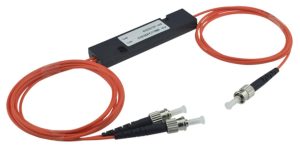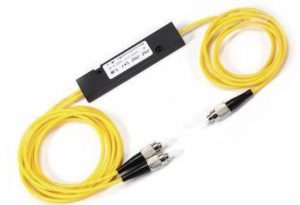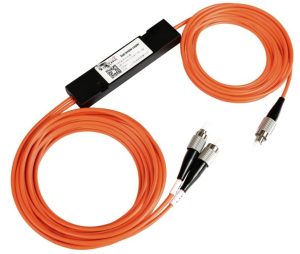Τύπος κωνικού λιωμένου (FBT) VS επίπεδος τύπος κυματοδηγού (PLC) οπτικός διαχωριστής
Οπτικός διαχωριστής (Σχίστης) είναι η βασική οπτική συσκευή που συνδέει τερματικό οπτικής γραμμής (OLT) και μονάδα οπτικού δικτύου (ΑΥΤΟΝ), its main function is to divide optical signals from one optical fiber to multiple optical fibers, and the performance of optical splitter is directly related to the stability of the entire network link.
The working principle of the optical splitter is: when the single-mode fiber conducts the optical signal, the energy of the light is not completely concentrated in the fiber core propagation, and a small amount is propagated through the cladding close to the fiber core, αυτό είναι, if the core of the two fibers is close enough, the mode field of the light transmitted in one fiber can enter the other fiber, and the optical signal is redistributed in the two fibers.

According to the different spectroscopic principles and manufacturing processes, optical splitters can be divided into two types: fused taper type (FBT) and planar waveguide type (PLC). How to choose between the two? What is the difference between apps?
Fusion taper type (FBT) οπτικός διαχωριστής
Melt cone technology is to bundle two or more optical fibers with no coating layer together, and then melt stretch on the cone pulling machine, and monitor the change of the splitting ratio in real time, and end the melt stretching after the splitting ratio reaches the requirements, one end retains a fiber (the rest is cut off) as the input end, and the other end is used as a multiple output end.

Planar waveguide type (PLC) οπτικός διαχωριστής
Planar waveguide optical splitter is an integrated waveguide optical power distribution device based on quartz substrate. The device is composed of an optical splitter chip and a fiber array at both ends, the chip is the core component, the quality of the chip and the shunt channel directly affect the price of the entire splitter, the chip has an input end and N output end waveguide. The fiber optic array is located on the upper surface of the chip and sealed with a shell to form an optical splitter with one input and N output fibers.

How to choose these two devices, the key is to consider their respective characteristics and user needs.
Στο παρόν, the mature cone drawing process can only pull less than 1×4 at a time. Devices above 1×4 are connected together with multiple 1×2s, για παράδειγμα, 1×8 can be composed of seven 1×2s, and then packaged. The planar waveguide optical splitter, a single device has many shunt channels, which can reach more than 64 καναλιών. The more divergences, the more obvious the cost advantage. In some cases where there are few shunts, the taper splitter is more affordable, and in scenarios such as FTTH, which require multiple wavelengths of optical transmission and have more users, PLC splitter is especially suitable for applications with a large scale of this shunt.
Στο παρόν, the production cost, PLC and three-window taper splitter, 1×8 is the critical point, PLC above 1×16 cost performance is obviously superior, 1×4 below the cone splitter cost performance is superior. In multi-channel splitting, because the taper splitter is made of multiple 1×2 connected packages, in addition to the large package size, it will also lead to poor uniformity of the splitting. Because it is impossible to achieve complete equalization of each 1×2 device, the final output light inhomogeneity of each channel of the 1×N device connected in series is amplified by product, and the more stages, the worse the uniformity. If good uniformity is required, the pairing needs to be accurately calculated.
The different distribution methods of the spectroscopic ratio are also one of the main differences between the two. The spectroscopic variability of taper splitters is the biggest advantage of this device. The spectroscopic splitter of the PLC splitter is evenly divided and the signal can be evenly distributed to the user. Για παράδειγμα, a 1×32 PLC splitter can divide an optical signal into 32 equal parts and then transmit it across 32 different channels. Sometimes, due to the inconsistency of the number of users and distance, it is necessary to distribute the optical power of different lines, and in this case, devices with different splitting ratios are needed, and FBT splitters are used.
Fusion taper (FBT) optical splitters and planar waveguide (PLC) optical splitters have their own advantages and disadvantages in passive optical network applications, and users can choose the appropriate optical splitter according to the specific application.





